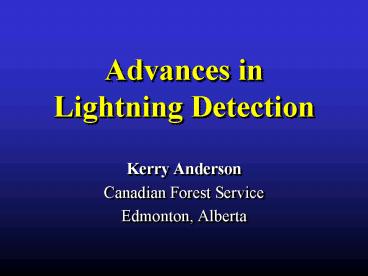Advances in Lightning Detection - PowerPoint PPT Presentation
1 / 34
Title:
Advances in Lightning Detection
Description:
The atmosphere is an electrical environment. The Earth has a natural net-negative charge that is countered by ... Lightning Climatology. Lightning Climatologies ... – PowerPoint PPT presentation
Number of Views:65
Avg rating:3.0/5.0
Title: Advances in Lightning Detection
1
Advances in Lightning Detection
- Kerry Anderson
- Canadian Forest Service
- Edmonton, Alberta
2
Introduction
The atmosphere is an electrical environment. The
Earth has a natural net-negative charge that is
countered by an equal and opposite charge in the
atmosphere.
Convective activity in the atmosphere collects
and redistributes this charge within clouds.
3
Introduction
Lightning is a release of charge buildup that
occurs within a cloud. This exchange of charge
can occur within a cloud, between clouds, from a
cloud to clear air, or between a cloud and ground.
4
Lightning Detection
5
Lightning Detection
- The current associated with each stroke within a
lightning flash is thousands of amps in strength.
This current sends out electromagnetic waves
that can be detected and mapped with lightning
detection systems. - There are two principle techniques of detecting
lightning - Magnetic direction finding (MDF)
- Time of arrival (TOA)
6
Lightning Detection
Magnetic direction finding (MDF) detects the
electromagnetic signature of a cloud to ground
lightning flash.
An antenna consisting of two orthogonal loops
picks up the magnetic field associated with a
flash. The relative strengths within each loop
determines the direction to the flash.
Detection by two or more antennae (a.k.a.
direction finders) within a network are used to
triangulate on the lightning flash location.
7
Lightning Detection
Time of Arrival (TOA) technique uses the
difference in the time when the electromagnetic
signature of a lightning flash is detected by two
or more sensors within a network.
8
Company Histories
9
Company Histories
10
Company Histories
The magnetic direction finding technique was
pioneered in the 1970s by Dr. E. Philip Krider,
Dr. Burt Pifer and Dr. Martin Uman, at the
University of Arizona. The first operational MDF
system was developed for use in Alaska for the
Bureau of Land Management (BLM) in
1976. Lightning Location and Protection, Inc.
(LLP) developed a commercial MDF product and made
it widely available in the 1980s.
11
Company Histories
The Time of Arrival technique was first developed
by Dr. Rodney Bent and Dr. Walter Lyons. A
prototype system was designed and tested in
1982. The Lightning Position and Tracking
Systems (LPATS) was made commercially available
by Atmospheric Research Systems, Inc. (ARSI).
12
Company Histories
Global Atmospherics Inc. (GAI) was formed by the
Sankosha Corporation of Japan. Sankosha
purchased and reorganized three of the worlds
leading companies LLP, ASRI and GeoMet Data
Services. The new company combined both MDF and
TOA systems to run off the same detection device
the IMPACT sensor. Global Atmospherics, Inc. was
later bought out by Vaisalla Instruments.
13
Company Histories
Recently, Time of Arrival Systems Inc. has
developed the Advanced Lightning Positioning
System (ALPS) based on the time of arrival
technique.
14
National Networks
15
US Networks
1984-1989 Three isolated networks were developed
in the US.
1991 Real-time and historic information becomes
commercially available
1989 Regional networks agreed to share the
data, creating the National Lightning Detection
Network (NLDN).
16
US Networks
Recently, TOA Systems has set up a similar
national system, the United States Precision
Lightning Network (USPLN).
17
Canadian Networks
In Canada, provincial forest protection agencies
set up individual lightning detection networks in
the early 1980s.
18
National Networks
In 1998, Environment Canada set up the Canadian
Lightning Detection Network (CLDN), which runs in
conjunction with the NLDN as the North American
Lightning Detection Network (NALDN).
19
Network Performance
20
Network Performance
The CDLN has a detection efficiency of 90 or
more for most of Canada.
The CDLN has a location accuracy of 500 metres
of less for most of Canada.
21
Network Performance
The USLPN has a detection efficiency of 95 or
more for most of the US and southern Canada.
The USLPN has a location accuracy of 150 metres
or less for most of the US.
22
Lightning Climatology
23
Lightning Climatologies
Days of observed Lightning within 20x20 cell
Data over several years can be used to build
lightning climatologies for Canada and for
Alberta.
24
Lightning Forecasts
25
Lightning Forecasts
- Environment Canada has recently begun producing
lightning forecasts. - Based on the work of William Burrows, these
forecasts predict the probability of lightning
occurrence for Canada at 24 km resolution in 3-hr
intervals to 48 hours.
26
Lightning Forecasts
Lightning data was collected from the North
American Lightning Detection Network (NALDN).
The CMC Global Environmental Model (GEM) was used
to provide predictors for the model.
27
Lightning Forecasts
Predictive models were built using
tree-structured regression. Separate models
were built for 5o x 5o cells for each predictive
period.
28
Lightning Forecasts
Probability of lightning occurrence.
29
Lightning Forecasts
Most likely category of lightning occurrence.
30
Lightning-caused Fire Prediction
31
Lightning-caused Fire Prediction
- The process of lightning-caused fires can be
broken into three distinct stages
Ignition
Survival
Arrival
The number of lightning-caused fires can be
predicted by modelling the probabilities of each
of these stages.
32
Lightning-caused Fire Prediction
Probability maps can be produced from daily
weather.
33
Lightning-caused Fire Prediction
Lightning can be layered upon the daily
probability maps to predict lightning-caused
fires.
34
Thank You































